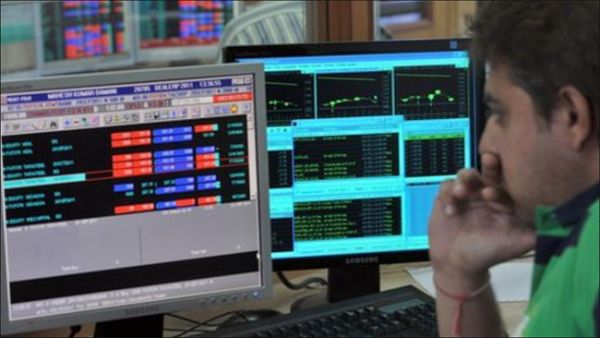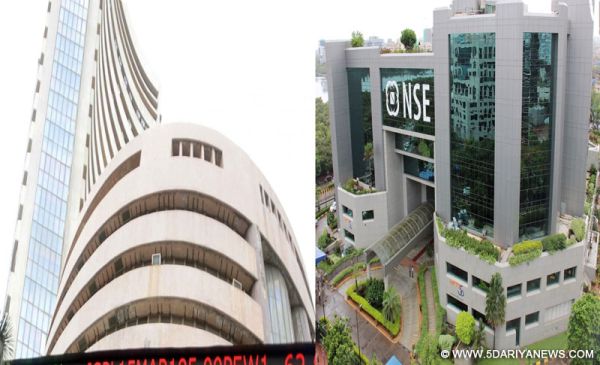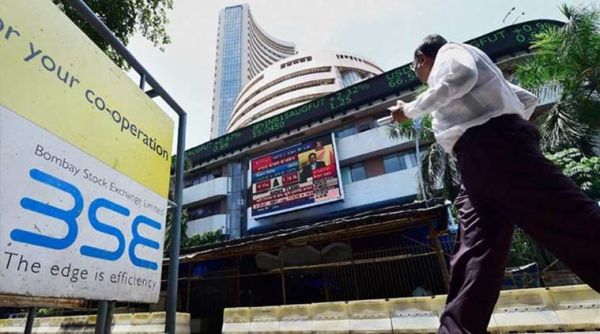
by admin | May 25, 2021 | Economy, Markets, News
 By Porisma P. Gogoi,
By Porisma P. Gogoi,
Mumbai : The Indian equity markets witnessed the steepest fall since November 2016 — when demonetisation was put into effect — after the long-term capital gains (LTCG) tax on equities was re-introduced in the Union Budget for 2018-19, leading the Sensex to shed over 800 points and the Nifty50 over 200 points in a single day.
Breaking an eight-week winning streak, the key equity indices gave way to the bears following a huge sell-off in the markets on the last trading day of the week.
On a weekly basis, the barometer 30-scrip Sensitive Index (Sensex) tanked 983.60 points or 2.73 per cent to close trade at 35,066.75 points.
The wider Nifty50 of the National Stock Exchange (NSE) closed the week’s trade at 10,760.60 points — shedding 309.05 points or 2.79 per cent from its previous week’s close.
Market observers said disappointing announcements in the Budget like on the LTCG tax and a higher-than-expected fiscal deficit target for 2018-19 dampened the risk-taking appetite of investors.
“Domestic markets closed lower as investors were disappointed after the government proposed 10 per cent LTCG tax on equity gains above Rs 1 lakh in the Union Budget. The sentiments also got spooked after the finance minister revised upward its fiscal deficit target,” D.K. Aggarwal, Chairman and Managing Director of SMC Investments and Advisors, told IANS.
“Also, market mood got badly suffered after Fitch Ratings on Friday said high debt burden of the government constrains India’s rating upgrade. Meanwhile, the divestment target for 2018-19 has been set at Rs 80,000 crore,” he added.
In the Budget announced on Thursday, Finance Minster Arun Jaitley proposed to tax LTCG on equities exceeding Rs 1 lakh at 10 per cent, which is expected to bring in revenue of Rs 20,000 crore.
The government also revised upwards its fiscal deficit target for 2017-18 to 3.5 per cent of the gross domestic product, or the equivalent of Rs 5.9 lakh crore, which was higher than the earlier target of 3.2 per cent for the current fiscal.
“The week gone by saw the Nifty correcting sharply. This week’s losses came after eight consecutive weeks of gains,” Deepak Jasani, Head, Retail Research, HDFC Securities, told IANS.
“Sectorally, there were no gainers. The top losers were the realty, pharma, PSU banks and energy indices,” he added.
On the currency front, the rupee weakened by 51 paise to close at 64.06 against the US dollar from its last week’s close at 63.55.
Provisional figures from the stock exchanges showed that foreign institutional investors purchased scrips worth Rs 2,099.45 crore, while domestic institutional investors worth Rs 145.73 crore during the week.
Figures from the National Securities Depository (NSDL) revealed that foreign portfolio investors bought equities worth Rs 2,923.18 crore, or $460.08 million, during January 29 and February 2.
Arpit Jain, AVP at Arihant Capital Markets, said: “This week, the Indian equity benchmarks fell 2.75 per cent the most since demonetisation week.”
“Both the indices fell by 2.4 per cent a day after government announced to tax equity investments held for more than a year to boost its revenue,” Jain told IANS.
The top weekly Sensex gainers were: Mahindra and Mahindra (up 1.73 per cent at Rs 768.50); Indusind Bank (up 1.54 per cent at Rs 1,755.60); Hero MotoCorp (up 1.51 per cent at Rs 3,623.65); Tata Consultancy Services (up 1 per cent at Rs 3,149.15); and Hindustan Unilever (up 0.11 per cent at Rs 1,372.70).
The losers were: Dr. Reddys Lab (down 15.25 per cent at Rs 2,122.10); Tata Steel (down 8.60 per cent at Rs 669.70); Axis Bank (down 7.95 per cent at Rs 564.95); ONGC (down 7.59 per cent at Rs 192.45); and Bharti Airtel (down 6.81 per cent at Rs 421.80).
(Porisma P. Gogoi can be contacted at porisma.g@ians.in)
—IANS

by admin | May 25, 2021 | Economy, Finance, Markets, News
 Mumbai : Ahead of the Union Budget 2018-19 presentation by Finance Minister Arun Jaitley in Parliament, the key Indian equity indices on Thursday traded with appreciable gains.
Mumbai : Ahead of the Union Budget 2018-19 presentation by Finance Minister Arun Jaitley in Parliament, the key Indian equity indices on Thursday traded with appreciable gains.
According to market observers, expectation of sops from the Union Budget, along with positive Asian markets and healthy buying in consumer durables, capital goods and banking stocks, lifted investors’ risk-taking appetite.
Around 10 a.m., the wider Nifty50 of the National Stock Exchange (NSE) traded higher by 63.35 points or 0.57 per cent at 11,091.05 points.
On the BSE, the barometer 30-scrip Sensitive Index (Sensex), which reclaimed the 36,000-mark at the opening, traded at 36,188.50 points — up 223.48 points or 0.62 per cent from its previous close.
The Sensex has so far touched a high of 36,226.97 points and a low of 36,021.88 points during intra-day trade.
The BSE market breadth was bullish with 1,495 advances and 636 declines.
“Indian indices opened in the green following Asian Indices which are trading in the positive territory,” Dhruv Desai, Director and Chief Operating Officer of Tradebulls, told IANS.
“Fertilisers, consumer durables, automobile, oil and gas, banking are among the key sectors which will be carefully watched ahead of Budget 2018-19 to be presented by Finance Minister Arun Jaitley later today,” he added.
On Wednesday, the benchmark indices closed in the negative territory on the back of negative global cues and heavy selling pressure in healthcare, consumer durables and capital goods stocks.
The Nifty50 fell by 21.95 points or 0.20 per cent to close at 11,027.70 points, while the Sensex closed lower by 68.71 points or 0.19 per cent at 35,965.02 points.
—IANS

by admin | May 25, 2021 | Economy, Markets, News
 Mumbai : Caution ahead of the Union Budget 2018-19 presentation led the key Indian equity indices to close in the negative territory for the second consecutive session on Wednesday.
Mumbai : Caution ahead of the Union Budget 2018-19 presentation led the key Indian equity indices to close in the negative territory for the second consecutive session on Wednesday.
Market observers said negative global cues and heavy selling pressure in healthcare, consumer durables and capital goods stocks pulled the equity indices lower.
However, some late-hour buying helped the key indices to recover from their day’s lows and the Nifty50 reclaimed the psychologically important 11,000-level.
The wider Nifty50 of the National Stock Exchange (NSE) fell by 21.95 points or 0.20 per cent to close at 11,027.70 points.
However, the barometer 30-scrip Sensitive Index (Sensex) of the BSE closed below the 36,000-mark at 35,965.02 points — down 68.71 points or 0.19 per cent from its previous close.
The BSE market breadth was bearish as 1,776 stocks declined against 1,036 advances.
“Markets corrected on Wednesday ahead of the Union Budget 2018-19 on Thursday, February 1. Investors and traders were turning cautious ahead of the event,” Deepak Jasani, Head, Retail Research, HDFC Securities, told IANS.
“Some late hour recovery was seen in the indices post 2.30 p.m. Broad market indices like the BSE mid-cap and small-cap indices lost more, thereby underperforming the main indices,” said Jasani.
In the broader markets, the S&P BSE mid-cap index closed lower by 1.29 per cent and the small-cap index by 0.83 per cent.
Provisional data with the exchanges showed that both foreign institutional investors turned net sellers and sold scrips worth Rs 136.63 crore.
However, domestic institutional investors invested in stocks worth Rs 1,294.66 crore.
The Indian rupee strengthened by two paise to close at 63.58 against the US dollar from its previous close at 63.60.
Vinod Nair, Head of Research, Geojit Financial Services, said: “Selling extended in the market as investors were awaiting the big budget day while the expectation for this budget is muted compared to what was anticipated over the last 2-years. The main requirement is to have a good balance between fiscal discipline and growth reforms.”
“Rural economy will be the key in the budget but infrastructure development and reforms are also likely to be highlighted. Some tinkering can be expected on corporate and individual taxation. If these basic points are addressed in the budget, we feel that market will maintain it’s luminous in the short to long-term,” Nair added.
Sectorwise, the S&P BSE healthcare index declined by 240.39 points, followed by capital index by 231.32 points and consumer durables index by 221.90 points.
On the other hand, the S&P BSE banking index edged higher by 124.79 points, oil and gas index by 77.60 points and energy index by 25.97 points.
Major Sensex gainers on Wednesday were: Kotak Bank, up 1.85 per cent at Rs 1,109.75; Reliance Industries, up 1.25 per cent at Rs 961.15; HDFC, up 1.16 per cent at Rs 1,955.70; IndusInd Bank, up 1 per cent at Rs 1,754.15; and Tata Motors, up 0.77 per cent at Rs 399.25.
Major Sensex losers were: Dr Reddy’s Lab, down 3.75 per cent at Rs 2,225.25; Tata Steel, down 3.49 per cent at Rs 705.05; Coal India, down 2.32 per cent at Rs 298.60; Hindustan Unilever, down 2.13 per cent at Rs 1,369.65; and Sun Pharma, down 2.02 per cent at Rs 579.35.
—IANS

by admin | May 25, 2021 | Economy, Markets, News
 By Porisma P. Gogoi,
By Porisma P. Gogoi,
Mumbai : Revival in corporate earnings, along with the country’s healthy economic growth outlook projected by the International Monetary Fund (IMF) and massive inflow of foreign funds kept the bulls riding in the Indian equity markets during the truncated trade week ended Thursday.
However, the key indices took a breather on the last trading day (Thursday) and closed in the red — snapping a six-day gaining streak — as investors booked profits amid higher crude oil prices and caution over January derivatives expiry, market observers said.
Nevertheless, it was the eighth consecutive week of gains for the benchmark indices.
The barometer 30-scrip Sensitive Index (Sensex), which crossed the psychologically important 36,000-mark during the week, surged by 538.86 points or 1.52 per cent to close at 36,050.44 points.
The wider Nifty50 of the National Stock Exchange (NSE) crossed the 11,000-points-level for the first time during the week and closed Thursday’s trade at 11,069.65 points — up 174.95 points or 1.60 per cent from its previous week’s close.
The indices scaled new records during the week.
On January 24, the BSE Sensex closed at a new high of 36,161.64 points after scaling a new high of 36,268.19 points during the intra-day trade.
On the same day, the Nifty50 closed at a new high of 11,086 points, after it scaled a fresh intra-day high of 11,110.10 points.
“Markets got a boost in the backdrop of budget expectations apart from positivity among investors on account of trade talks being held at Davos,” D.K. Aggarwal, Chairman and Managing Director of SMC Investments and Advisors, told IANS.
“Also, the bulls got support after government announced that it would infuse Rs 88,139 crore into 20 public sector banks through recapitalisation bonds and budgetary support in this financial year. The aim of the government is to strengthen these banks’ lending capacity and thereby pulling the country out of a three-year low credit growth,” he added.
The government on Wednesday announced plans to infuse over Rs 1 lakh crore, including Rs 80,000 crore through recap bonds and Rs 8,139 crore as budgetary support, during the current fiscal seeking to perk up public sector banks (PSBs) that have been hit by huge non-performing assets.
“Post re-capitalisation allocation worth Rs 880 billion, PSBs corrected. However, private bank and infra stocks gained,” Arpit Jain, AVP at Arihant Capital Markets, told IANS.
“FIIs (foreign institutional investors) were net buyers during the month of January worth $1 billion,” said Jain.
On the investment side, provisional figures from the stock exchanges showed that FIIs purchased scrips worth Rs 4,510.59 crore, while domestic institutional investors divested stocks worth Rs 1,452.38 crore during the week.
Figures from the National Securities Depository (NSDL) revealed that foreign portfolio investors bought equities worth Rs 5,990.74 crore, or $939.38 million, during January 22-25.
According to Vinod Nair, Head of Research, Geojit Financial Services, positive global cues and revival in earnings supported the underlying sentiments.
“The rally was broadbased led by IT, oil and gas, financials, metals, pharma and PSBs. In the latest World Economic Outlook, the IMF has projected India’s GDP to grow at 7.8 per cent which helped the investor sentiments,” said Nair.
“F&O (futures and options ) expiry, long weekend, oil prices at three year at $71/bbl, lack of fresh triggers post a series of new high and sell-off in PSB stocks limited gains for the week,” he added.
On the currency front, the rupee strengthened by 30 paise to close at 63.55 against the US dollar from its last week’s close at 63.85.
The top weekly Sensex gainers were: ONGC (up 7.32 per cent at Rs 208.25); Tata Consultancy Services (up 7.14 per cent at Rs 3,117.85); Yes Bank (up 6.83 per cent at Rs 363.50); Coal India (up 5.85 per cent at Rs 299.65); and Adani Ports (up 5.61 per cent at Rs 437.60).
The losers were: Bharti Airtel (down 8.47 per cent at Rs 452.60); Tata Motors (DVR)(down 6.10 per cent at Rs 228); Tata Motors (down 4.44 per cent at Rs 400.20); Wipro (down 4.32 per cent at Rs 311.95); and Asian Paints (down 3.36 per cent at Rs 1,149.75).
The equity markets were closed on January 26 (Friday) for Republic Day.
(Porisma P. Gogoi can be contacted at porisma.g@ians.in)
—IANS

by admin | May 25, 2021 | Economy, Markets, News
 By Porisma P. Gogoi,
By Porisma P. Gogoi,
Mumbai : Upbeat quarterly corporate earnings along with influx of foreign funds and major decisions undertaken by the government during the week catapulted the key Indian equity indices — the Sensex and the Nifty50 — to record high levels.
The benchmark indices extended their bull run for the seventh consecutive week with banking and IT stocks giving a major thrust to the upward trajectory, said market observers.
The barometer 30-scrip Sensitive Index (Sensex), which crossed the psychologically important 35,000-mark during the week, augmented by a substantial 919.19 points or 2.66 per cent to close at a fresh level of 35,511.58 points.
The wider Nifty50 of the National Stock Exchange (NSE) crossed the 10,900-points-level for the first time this week.
However, the Nifty50 failed to sustain that level at the closing on Friday. The index closed trade at a fresh high of 10,894.70 points — up 213.45 points, or 2 per cent, from its previous week’s close.
The indices also touched their new 52-week highs. On Friday, the Sensex scaled a fresh intra-day high of 35,542.17 points and the Nifty50 of 10,906.85 points.
“The recent rally was undoubtedly dominated by the technology and banking space. The banking stocks got lured on Thursday after the news that the government is mulling allowing 100 per cent FDI (foreign direct investment) in the sector,” D.K. Aggarwal, Chairman and Managing Director of SMC Investments and Advisors, told IANS.
On the global front, stock markets across the globe rallied on the back of optimism in the US economy and expectations for a strong earnings season, Aggarwal said.
“Investors’ interest resumed in the market again after the Goods and Services Tax (GST) Council announced cut in the tax rate on 29 goods and 54 categories of services,” Arpit Jain, AVP at Arihant Capital Markets, told IANS.
“Encouraging Q3 FY18 results by blue-chip firms like HDFC Bank and ITC added to the cheer,” he said.
In a major decision on Thursday, the GST Council slashed the rates on 54 services and 29 items, including old and used motor vehicles, public transport buses run on bio-fuel, sugar-boiled confectionery and packaged water, which cheered investors.
On the investment side, provisional figures from the stock exchanges showed that foreign institutional investors purchased scrips worth Rs 4,234.46 crore, while domestic institutional investors divested stocks worth Rs 698.65 crore during the week.
Figures from the National Securities Depository (NSDL) revealed that foreign portfolio investors bought equities worth Rs 3,596.2 crore, or $563.3 million, during January 15-19.
“The announcement of the Ministry of Finance that the government will reduce the additional borrowing of dated securities for FY18 to Rs 200 billion from Rs 500 billion that was earlier announced helped alleviate some of the uncertainty,” Shibani Kurian, Senior Vice President and Head of Equity Research, Kotak Mutual Fund, told IANS.
“The government has reassessed its additional borrowing requirements, taking note of revenue receipts and expenditure patterns,” added Kurian.
On the currency front, the rupee weakened by 22 paise to close at 63.85 against the US dollar from its last week’s close at 63.63.
“Sectorally, the top gainers were the Bank Nifty, IT, PSU banks and FMCG indices. The top losers were the realty, metal and energy indices,” Deepak Jasani, Head – Retail Research, HDFC Securities, told IANS.
The top weekly Sensex gainers were: ICICI Bank (up 11.32 per cent at Rs 353.55); HDFC (up 7.90 per cent at Rs 1,900.45); Tata Consultancy Services (up 6.56 per cent at Rs 2,954.75); Axis Bank (up 6.21 per cent at Rs 590.25); and Infosys (up 6.01 per cent at Rs 1,143.25).
The losers were: Coal India (down 7.65 per cent at Rs 284.45); Tata Motors (down 3.94 per cent at Rs 418.95); Tata Motors (DVR) (down 3.39 per cent at Rs 243.95); ONGC (down 3.32 per cent at Rs 193.60); and Hero MotoCorp (down 2.58 per cent at Rs 3,590.75).
(Porisma P. Gogoi can be contacted at porisma.g@ians.in)
—IANS




